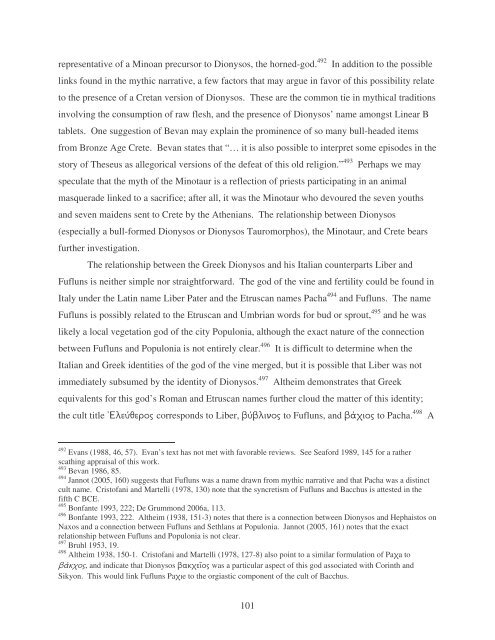Final Draft - Preview Matter - Florida State University
Final Draft - Preview Matter - Florida State University
Final Draft - Preview Matter - Florida State University
You also want an ePaper? Increase the reach of your titles
YUMPU automatically turns print PDFs into web optimized ePapers that Google loves.
epresentative of a Minoan precursor to Dionysos, the horned-god. 492 In addition to the possible<br />
links found in the mythic narrative, a few factors that may argue in favor of this possibility relate<br />
to the presence of a Cretan version of Dionysos. These are the common tie in mythical traditions<br />
involving the consumption of raw flesh, and the presence of Dionysos’ name amongst Linear B<br />
tablets. One suggestion of Bevan may explain the prominence of so many bull-headed items<br />
from Bronze Age Crete. Bevan states that “… it is also possible to interpret some episodes in the<br />
story of Theseus as allegorical versions of the defeat of this old religion.” 493 Perhaps we may<br />
speculate that the myth of the Minotaur is a reflection of priests participating in an animal<br />
masquerade linked to a sacrifice; after all, it was the Minotaur who devoured the seven youths<br />
and seven maidens sent to Crete by the Athenians. The relationship between Dionysos<br />
(especially a bull-formed Dionysos or Dionysos Tauromorphos), the Minotaur, and Crete bears<br />
further investigation.<br />
The relationship between the Greek Dionysos and his Italian counterparts Liber and<br />
Fufluns is neither simple nor straightforward. The god of the vine and fertility could be found in<br />
Italy under the Latin name Liber Pater and the Etruscan names Pacha 494 and Fufluns. The name<br />
Fufluns is possibly related to the Etruscan and Umbrian words for bud or sprout, 495 and he was<br />
likely a local vegetation god of the city Populonia, although the exact nature of the connection<br />
between Fufluns and Populonia is not entirely clear. 496 It is difficult to determine when the<br />
Italian and Greek identities of the god of the vine merged, but it is possible that Liber was not<br />
immediately subsumed by the identity of Dionysos. 497 Altheim demonstrates that Greek<br />
equivalents for this god’s Roman and Etruscan names further cloud the matter of this identity;<br />
the cult title /% & ( corresponds to Liber, B B& ( to Fufluns, and B4 ? ( to Pacha. 498 A<br />
492<br />
Evans (1988, 46, 57). Evan’s text has not met with favorable reviews. See Seaford 1989, 145 for a rather<br />
scathing appraisal of this work.<br />
493<br />
Bevan 1986, 85.<br />
494<br />
Jannot (2005, 160) suggests that Fufluns was a name drawn from mythic narrative and that Pacha was a distinct<br />
cult name. Cristofani and Martelli (1978, 130) note that the syncretism of Fufluns and Bacchus is attested in the<br />
fifth C BCE.<br />
495<br />
Bonfante 1993, 222; De Grummond 2006a, 113.<br />
496<br />
Bonfante 1993, 222. Altheim (1938, 151-3) notes that there is a connection between Dionysos and Hephaistos on<br />
Naxos and a connection between Fufluns and Sethlans at Populonia. Jannot (2005, 161) notes that the exact<br />
relationship between Fufluns and Populonia is not clear.<br />
497<br />
Bruhl 1953, 19.<br />
498<br />
Altheim 1938, 150-1. Cristofani and Martelli (1978, 127-8) also point to a similar formulation of Pa?a to<br />
B4 ? (, and indicate that Dionysos B ? D ( was a particular aspect of this god associated with Corinth and<br />
Sikyon. This would link Fufluns Pa? e to the orgiastic component of the cult of Bacchus.<br />
101

















